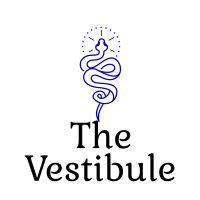
Doctor Who
“The Haunting of Villa Diodati”
Series 12, Episode 8
Written by Maxine Alderton
Directed by Emma Sullivan
Starring Jodie Whittaker, Tosin Cole, Mandip Gill, and Bradley Walsh
Guest Starring Maxim Baldry, Stefan Bednarczyk, Jacob Collins-Levy, Lili James, Nadia Parkes, Lewis Rainer, and Patrick O’Kane
49 minutes
Original broadcast 16 February 2020
1. That Night in 1816
If anyone—you, me, them (whomever “they” might be)—conducted a poll asking people to rank the most famous European literary events of the past three centuries, the evening of 16 June 1816 would loom large in the responses. This day-and-night span might conceivably top the list, but, if not, that fateful Sunday would almost certainly crack the top five, perhaps the top three, and maybe—just maybe—score the number-two slot behind 1 January 1818, when the small (meaning, virtually unknown) printing house of Lackington, Hughes, Harding, Mavor, & Jones loosed a modest, three-volume book upon its unsuspecting British readers.
The author? Anonymous (at first).
The location? London, specifically Finsbury Square (home to Lackington’s offices).
The title? Frankenstein; or, The Modern Prometheus.
A touch ungainly, perhaps, but, dear reader, I presume you’re aware of this text even if you’ve never read it. There’s scarcely anyone over the age of five who isn’t.
Frankenstein the novel may have officially entered public consciousness on New Year’s Day 1818, but its premise (about Victor Frankenstein re-animating a corpse of grafted-together body parts stolen from cemeteries, charnel houses, and medical labs) entered this world on 16 June 1816, on the shores of Lake Geneva, in a mansion named the Villa Diodati.
This estate had been rented by George Gordon, better known to his European readers as Lord Byron, the famous poet who had travelled to Switzerland that April alongside his personal physician, Dr. John Polidori, to escape a series of proliferating scandals, including Byron’s recent separation from his wife (the mathematician Annabella Milbanke), reports (running to the dozens) of illicit liaisons with actresses and sex workers of all kinds, and, most damningly, rumors of an incestuous affair with his half-sister (the prim, or so everyone assumed, Augusta Maria Leigh). The continual and compounding fiscal debts that Byron had accrued (and that he couldn’t—or wouldn’t—repay) didn’t help matters, either.
Into this tempest rode Byron’s acquaintance and fellow poet, Percy Bysshe Shelley, who was travelling with his lover, Mary Wollstonecraft Godwin (but not his wife, Harriet Shelley); his and Mary’s out-of-wedlock son, William; and Mary’s stepsister, Claire Clairmont (Percy’s alleged former mistress, although rumors of them indulging on-again-off-again sexual dalliances persisted, even after Claire became romantically involved with Byron and, inevitably, pregnant with Byron’s child).
The middle months of the year, to make matters worse, were meteorologically miserable across the Continent—and, in truth, throughout much of the world—as plunging temperatures, incessant rain, and furious windstorms caused 1816 to be dubbed “The Year Without a Summer,” meaning that this ragtag group couldn’t spend as much time outdoors as its members preferred.
So, how might such unconventional, oversexed, and imaginative people pass their time when not lamenting the bad weather; discussing the creative process; getting on each other’s nerves; and bed hopping their way to moments of fiery passion, temporary joy, and surefire recrimination? They, of course, did what anyone would do: scare themselves witless by reading, aloud and to one another, eight German ghost stories from an anthology titled, appropriately enough, Fantasmagoriana (translated into French by geographer Jean-Baptiste Benoît Eyriès) and then, for good measure, concocting their own tales of terror.
Even occasional readers know what happened next. Most accounts claim that Mary, Claire, Percy, Polidori, and Byron devised a contest to see who could write the most horrifying story possible, and out of the ensuing tumult came two verifiable classics: Polidori’s The Vampyre; A Tale, which some commentators proclaim the progenitor of the Western vampire novel (certainly in its Romantic and Gothic forms) as we know it today, and—you guessed it—Wollstonecraft Godwin’s (she wouldn’t marry Shelley and take his surname until 30 December 1816) Frankenstein.
The story of Frankenstein’s conception and creation—with all the carnal undercurrents implied by this phraseology—is so pregnant with gossip, innuendo, and commotion that one wonders why it took Doctor Who until Series 12’s eighth episode, a spooky and spectacular installment titled “The Haunting of Villa Diodati,” to spin these happenings to New Who’s advantage. Better late than never, we might say, invoking a cliché that, in this instance, reveals appreciable truths, for although “Villa Diodati” dials down the more disreputable elements and interpersonal complications besetting this mansion’s residents, sufficient whiffs of indecency remain to make this trip in the TARDIS one of the best since the show returned to television in 2005.
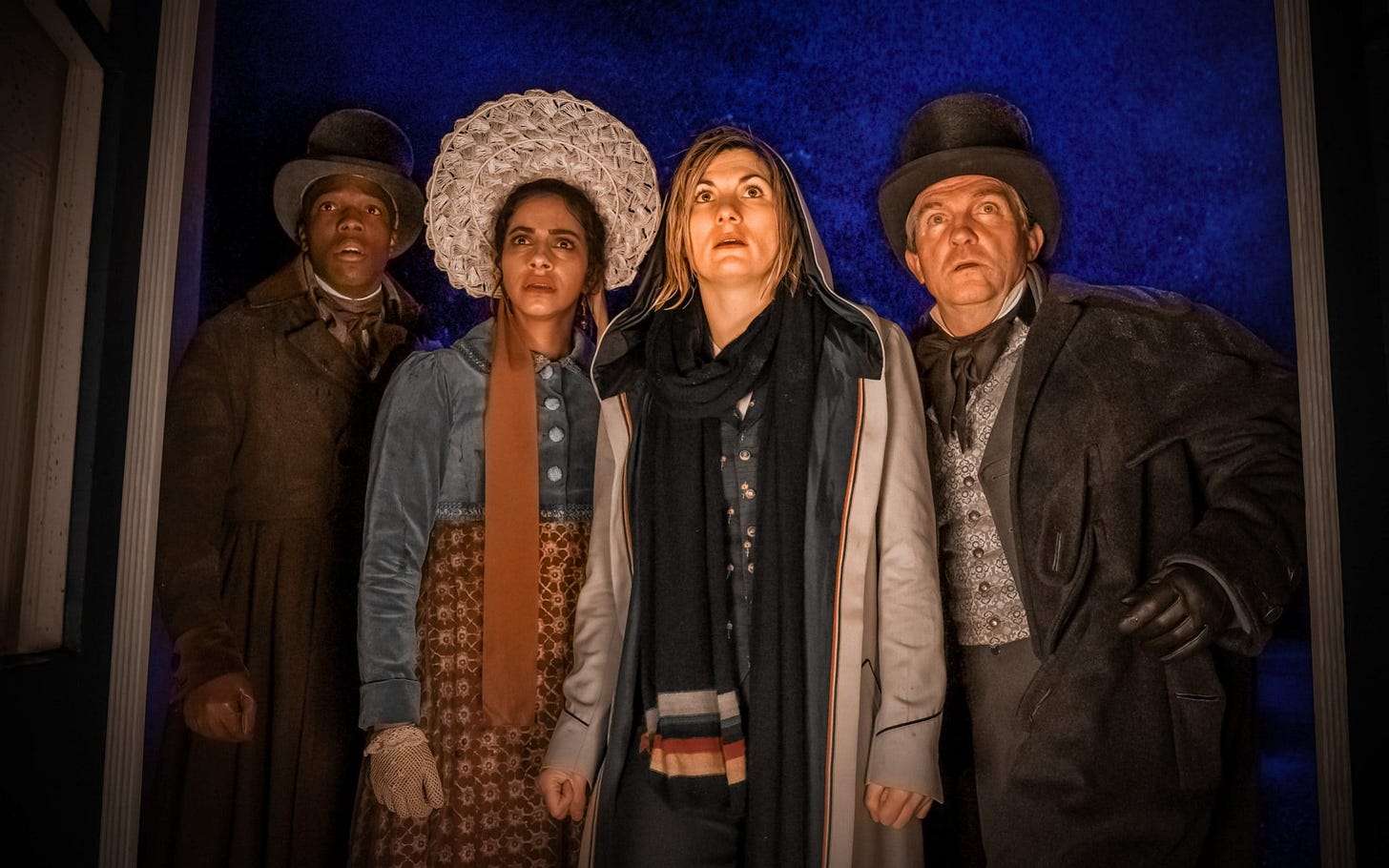
2. That Place on the Lake
The night of Frankenstein’s parturition has been dramatized before, most memorably in Ken Russell’s gonzo 1986 film Gothic, full of séances, goblins, and, in a scene indelible to anyone who’s seen it, Myriam Cyr’s Claire Clairmont having a miscarriage while Gabriel Byrne’s Byron performs cunnilingus on her. “The Haunting of Villa Diodati” avoids these erotic developments, substituting instead people trapped in rooms and on staircases (unable to leave because each exit—in M.C. Escher fashion—leads them directly back to the spaces and places they just vacated), mysterious lights hovering over Lake Geneva, and trusted servants being killed by an apparition revealed be a damaged Cyberman searching for someone he calls “the Guardian.”
Yes, friends, “Villa Diodati” makes good on the warning that John Barrowman’s Captain Jack Harkness asked the Thirteenth Doctor’s (Jodie Whittaker’s) companions—Ryan Sinclair (Tosin Cole), Yasmin “Yaz” Khan (Mandip Gill), and Graham O’Brien (Bradley Walsh)—to deliver three episodes prior, in “Fugitive of the Judoon,” by making this lone Cyberman—named, we come to learn, Ashad (Patrick O’Kane)—the bugaboo whose spectral presence drives all the action.
And what action it is.
After her confident debut in “Can You Hear Me?,” director Emma Sullivan transforms “Villa Diodati” into a sumptuous, savvy, and scary retelling of 16 June 1816’s eerie events. Sullivan doesn’t do so alone, of course, working from a terrific script written by first-time New Who contributor Maxine Alderton, whose major credit before being invited by showrunner Chris Chibnall to join Doctor Who’s Series 12 writing staff was authoring 123 episodes of British broadcaster ITV’s soap opera Emmerdale (1972-Present),1 making her the perfect person to dramatize the soapy lives of Mary, Claire, Percy, Polidori, and Byron on that infamous evening. Before this group can get up to too many shenanigans, it’s interrupted by Team TARDIS’s arrival in the middle of—what else?—a rainstorm whose wind, chill, and fog portend dastardly deeds.
The term atmospheric may be overused when discussing Gothic texts of all stripes and media, but becomes unavoidable in any honest assessment of “Villa Diodati.” The production crew, under Sullivan’s and Chibnall’s vigilant supervision, outdoes its previous Series 12 triumphs, which—lest we forget—began the season by staging absurdly enjoyable, James Bond-style action sequences (in the two-part premiere, “Spyfall”) before introducing Jo Martin’s glorious, brand-new Fugitive Doctor in “Fugitive of the Judoon.”
Costume designer Ray Holman’s clothing; director of photography Ed Moore’s cinematography; Agnieszka Liggett’s and Joel Skinner’s editing; and—as always—composer Segun Akinola’s music are marvels to behold, indeed as good as any feature film despite this entry’s smaller budget. Yes, the work of everyone behind the camera is unimpeachable, telling us that their faith in the quality of Alderton’s teleplay inspired them to go above and beyond.
So how good are the people in front of the camera?
Let us count the ways.
The cast—individually and collectively—is, in alphabetical order: Aces. Crackerjack. Fabulous. Remarkable. Terrific.
I could continue, but these superlatives no doubt strike my readers as the sort of over-the-top claptrap that the term excessive was invented to describe.
And I agree. How could I not? Yet this agreement doesn’t alter the happy reality that “The Haunting of Villa Diodati” is a beautifully crafted, opulently produced, and immensely pleasurable hour of television.
All the elements come together to convince me that Villa Diodati is a real mansion, not three separate locations in Wales, including Brigend’s Merthyr Mawr House. All praise to art director Julia Jones and her set-dressing teams as tribute.
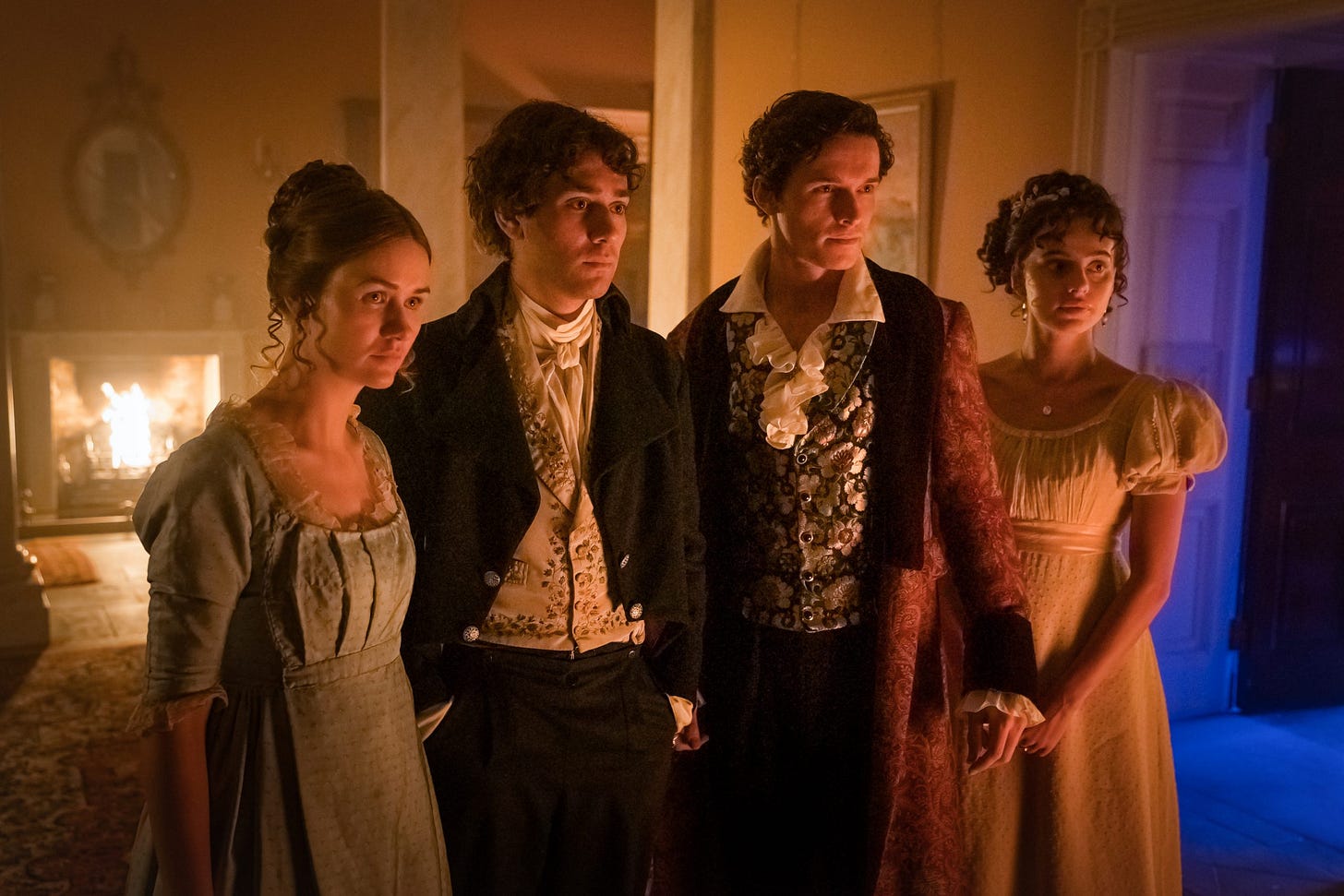
The guest cast is sublime, with Lili Miller’s Mary Wollstonecraft Godwin and Nadia Parkes’s Claire Clairmont ceding no ground to the sexist depictions of both women in too many previous dramatizations of this famous tale. Both performers may be in the early stages of their careers, with this episode being Miller’s first major onscreen role anywhere, but you wouldn’t know it given how well they acquit themselves.
Miller plays one of the most famous English writers of all time with a confidence and sensitivity that equals Natasha Richardson’s work as Wollstonecraft Godwin in the aforementioned Gothic (and that surpasses Elle Fanning’s middling portrayal of the author in the 2017 feature film Mary Shelley, directed by Haifaa al-Mansour and written by Emma Jensen).
Parkes played her first major role in 2019, as Rosa de Vargas, a lady-in-waiting to the teenage Catherine of Aragorn, in Emma Frost’s and Matthew Graham’s The Spanish Princess, their two-season, Starz Network adaptation of Philippa Gregory’s 2005 novel The Constant Princess. Here, Parkes transforms Claire Clairmont into a woman who realizes just how inconstant, unworthy, and cowardly Byron can be, enumerating his narcissistic actions in “Villa Diodati’s” final act by saying, “You pursued Mrs. Doctor without a care for my presence, belittled my thoughts and opinions, and then proceeded to use my person as a human shield.”
All true, yet when Byron—played by Jacob Collins-Levy with the unearned haughtiness that makes even placid viewers wish to punch the man in his smirking face—merely asks “And?” in reply (clearly expecting to get away with this terrible behavior just as he has in the past), Claire/Parkes fixes him with an icy stare and says, “And the spell is broken, my lord,” remaining resolute even if her eyes show just a hint of Claire’s sadness at Byron’s thoughtless betrayal. It’s a wonderful moment, and a superb performance by an actress who, like Lili Miller, will undoubtedly impress us in her future roles.
Both Villa Diodati and “Villa Diodati” profit by another expert guest turn, this one by Stefan Bednarczyk as the estate’s long-suffering valet Fletcher, who snorts, grimaces, and rolls his eyes whenever Byron speaks, especially when the lascivious lord tries to charm—without success, it must be noted—the women in his path. Although brief, Bednarczyk’s expert comic acting lets us know that Byron, despite his fabled seductive prowess, is in fact a blowhard whose attractions are easily punctured by small comments, as Yaz (who receives a few Byronic compliments) and the Doctor (who receives the lion’s share) quickly discover.
One of the best jokes in Alderton’s script finds the Doctor quoting the second line of Byron’s famous 1815 poem “She Walks in Beauty” back at him just after Byron puts the moves on her (so to speak) by quoting this poem’s first line (also it’s title) as an opening conversational gambit. The befuddlement on Byron’s face (well played by Collins-Levy) at this rebuke draws a quick, private smile from the Doctor, whom Whittaker makes, as usual, a sprightly-yet-commanding presence.
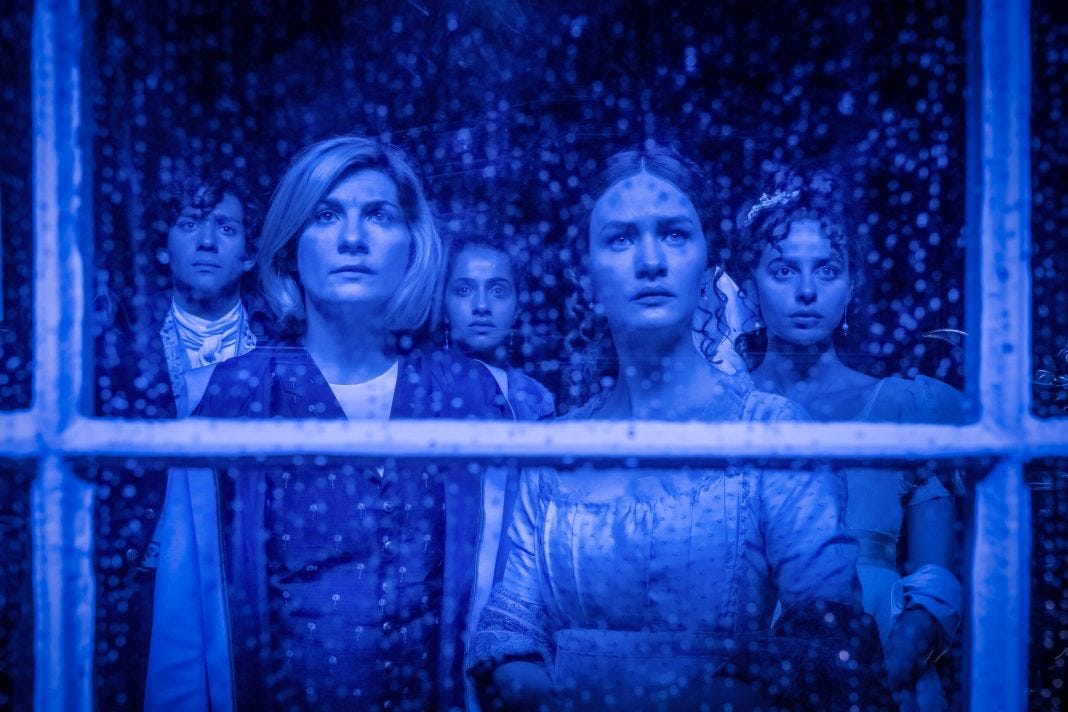
3. That Cyborg in the Cellar
“The Haunting of Villa Diodati,” as these comments attest, has it all: excellent locations, beautiful design work, superb performances from everyone involved, and, to boot, a fascinating antagonist. Patrick O’Kane’s Ashad is a partially converted Cyberman who, lacking the inhibitor device that suppresses all emotion, makes him an intelligent, relentless, and cruel opponent. Moreover, Ashad’s Cybersuit is rusted, discolored, and damaged, with his helmet missing a large chunk that exposes the left side of his face (including the eye), which allows O’Kane, using only half his features, to bring Ashad to malevolent and frightening life.
Previous Cyberman stories—whether Series 2’s terrific two-part “Rise of the Cybermen” / “The Age of Steel” (significantly, the installments that introduced Russell T. Davies’s redesigned version of these Classic Who villains to New Who for the first time), 2008’s Christmas Day Special “The Next Doctor,” or Series 8’s two-part finale, “Dark Water” / “Death in Heaven”—frequently see the major Cyber character screaming in rage despite the species’ supposed emotionlessness, but O’Kane so expertly works his way toward such an outburst that, when it arrives near the end of “Villa Diodati,” the sight of Ashad’s wrath is disturbing. Before then, O’Kane uses his baritone voice—partially digitized to suggest Ashad’s incomplete cyber-conversion—to tremendous effect, moving from silky whispers through mechanical precision to stentorian pronouncements that cause Alderton’s well-honed dialogue to soar.
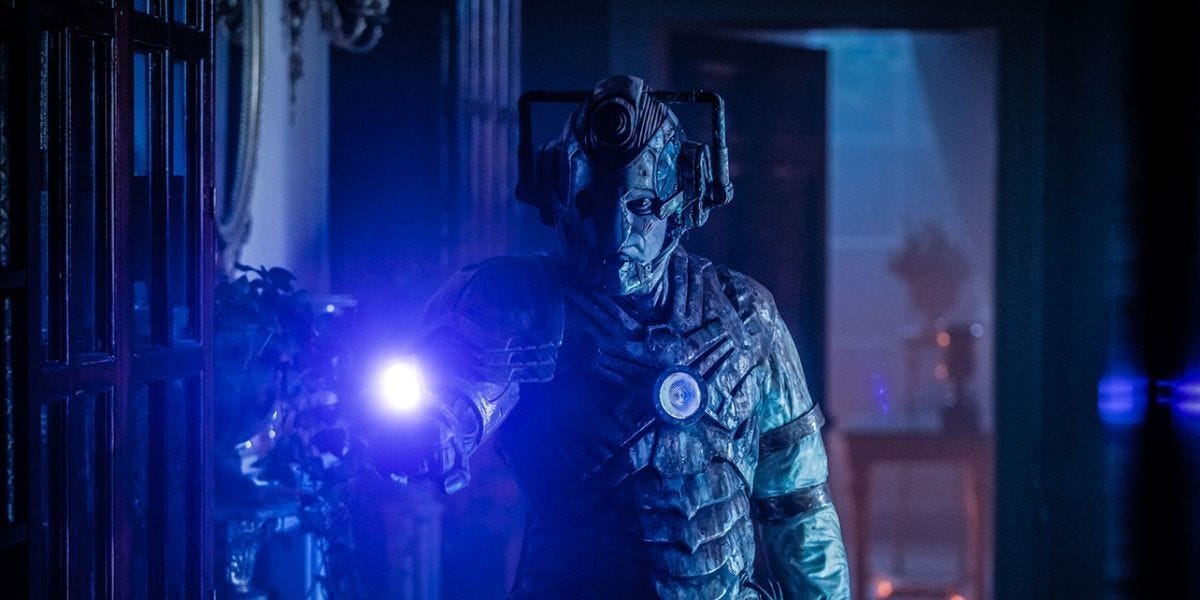
Yet why would a Cyberman—indeed, the Lone Cyberman of Jack Harkness’s prophecy—travel to 1816 Geneva? Ashad, you see, is tracking what he calls “the Cyberium,” an artificial-intelligence system that stores nothing less than the amassed knowledge and future history of all Cybermen. Appearing as a floating, quicksilver sphere whose tentacles pulsate with energy, this vital database was sent into the past (by a group that Jack Harkness, in “Fugitive of the Judoon,” calls “the Alliance”) to prevent the fallen Cyber Empire from rising again.
Ashad’s mission will ensure that the Cyber Empire can re-establish itself, but travelling through time causes Ashad to phase between different states of being, which explains the ghostly presences around Lake Geneva that haunt this episode, as well as—the Doctor claims—the strange weather afflicting the area. Rather than resulting from a volcanic explosion (namely Indonesia’s Mount Tambora on 10 April 1815), the region’s meteorological instability results from the Cyberium arriving from the future. This alternate explanation of the Year Without a Summer’s strange weather patterns plays to Doctor Who’s strengths as a time-travel program that mixes human history with caprices of its own invention.
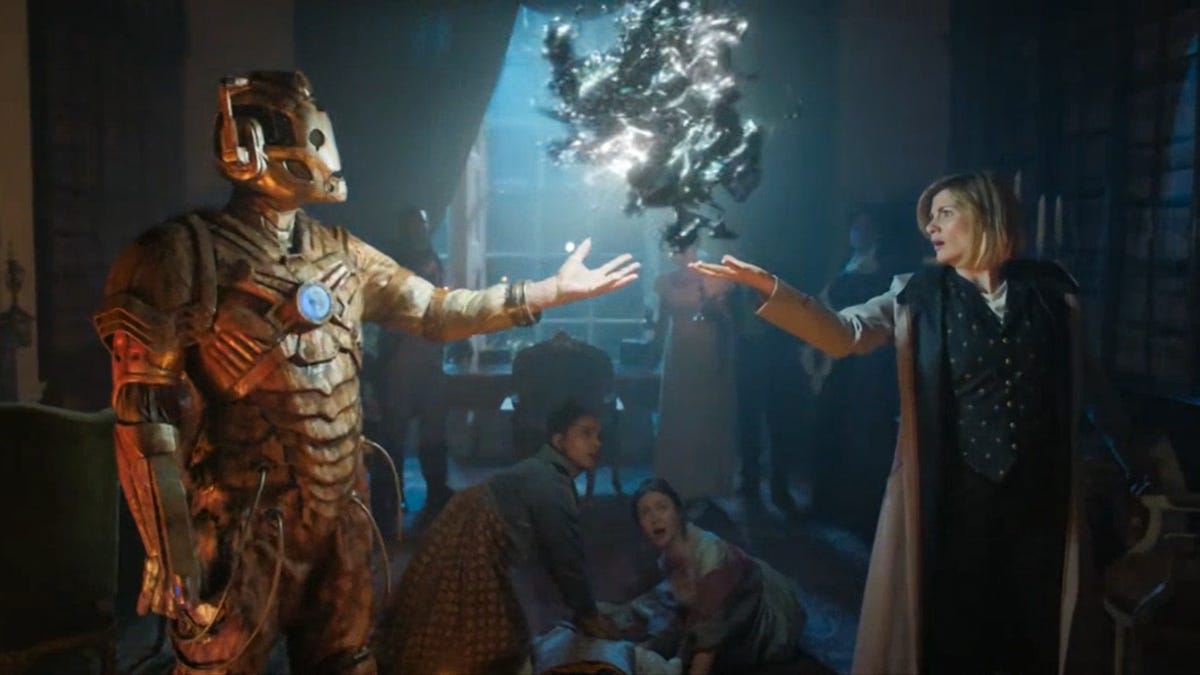
This storyline, moreover, transforms “The Haunting of Villa Diodati” into the two-part Series 12 finale’s prologue, or, essentially, the first of this finale’s three parts (even if “Villa Diodati” isn’t billed as such). Ashad wishes to locate the Cyberium, but Percy Bysshe Shelley (Lewis Rainer) finds it first, while strolling next to the lake, and absorbs it through his skin. This process alters Shelley’s physical state so that no one else can see or hear him. Many spectral happenings chronicled in “Villa Diodati” are, indeed, the transformed Shelley trying to contact his friends, but never succeeding.
Shelley retreats to the mansion’s cellar out of frustration, but, when discovered by Team TARDIS and Ashad, surrenders the Cyberium to the Doctor, who absorbs it into her body. This scene is wonderfully performed, with the Doctor caught in a moral quandary: If she allows the Cyberium to remain inside Shelley’s body, it will destroy his mind and alter humanity’s future, yet allowing Ashad to escape with the Cyberium risks the death of billions more at the hands of the revived Cyber Empire.
Whittaker is splendid here, especially when she chastises her three companions for their myopia about the implications of the decision she must make. Whittaker is particularly strong when the normally chirpy Doctor rebukes Ryan for suggesting that they sacrifice Shelley’s life to save so many others: “Words matter. One death, one ripple, and history will change in a blink. . . . Yeah, ‘cause sometimes this team structure isn’t flat. It’s mountainous, with me at the summit, in the stratosphere, alone, left to choose. Save the poet, save the universe. Watch people burn now or tomorrow. Sometimes, even I can’t win.”
When the Doctor allows Ashad to depart with the Cyberium, she knows that she risks condemning future generations to ruin. This choice also sets in motion the events of Series 12’s final two installments (“Ascension of the Cybermen” / “The Timeless Children”), making the effortless manner by which this entry progresses a sign of just how tightly Maxine Alderton conceives and constructs “Villa Diodati’s” teleplay (under Chris Chibnall’s supervision).
Although this installment offers an ingenious gloss on the night of Frankenstein’s birth, its alterations to that evening’s actual details make for spectacular entertainment (even when they diverge markedly from the official record, as documented by books like Emily W. Sunstein’s superb 1988 biography Mary Shelley: Romance and Reality and Dorothy & Thomas Hooblers’ 2009 monograph The Monsters: Mary Shelley and the Curse of Frankenstein).
Mary Godwin, in “Villa Diodati,” notes that Ashad’s body is assembled from different limbs and energized by lightning, offering clear inspirations for Victor Frankenstein’s famous creation in her 1818 novel, while Polidori’s (Maxim Baldry’s) short temper, love-hate relationship with Byron, and sleepwalking (sometimes through walls) all appear in The Vampyre in one form or another. This installment includes so many delicious details of similar kind that it qualifies as one of the finest episodes since Chibnall became showrunner and, for good measure, since New Who returned to television in 2005.
Best of all, “The Haunting of Villa Diodati” is a story, like its finest haunted-house siblings (see Series 1’s “The Unquiet Dead,” Series 2’s “Tooth and Claw,” Series 7’s “Hide,” and Series 10’s “Knock Knock”), that only Doctor Who can tell. Maxine Alderton, Chris Chibnall, Emma Sullivan, the cast, and the crew knock this entry out of the proverbial park, so let’s pray that their batting average remains as high in Series 12’s final, dual installment.
FILES
NOTE
Alderton isn’t the first Emmerdale alumna to find success on New Who. When, in 2012, Jenna Coleman (then billed as Jenna-Louise Coleman) was hired to play Clara Oswald for Series 7, she was best known to British audiences for her role as Jasmine Thomas (from 2005 to 2009) in 180 episodes of ITV’s famous soap opera. Although Alderton didn’t write any of Coleman’s Emmerdale episodes, Alderton (then billed as Maxine Exley) got her start on the series by working as a script editor beginning in 2006, so Alderton’s and Coleman’s Emmerdale tenures did overlap.




